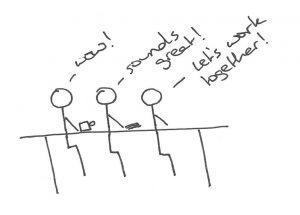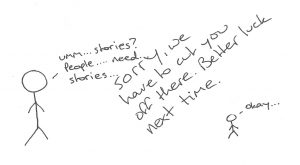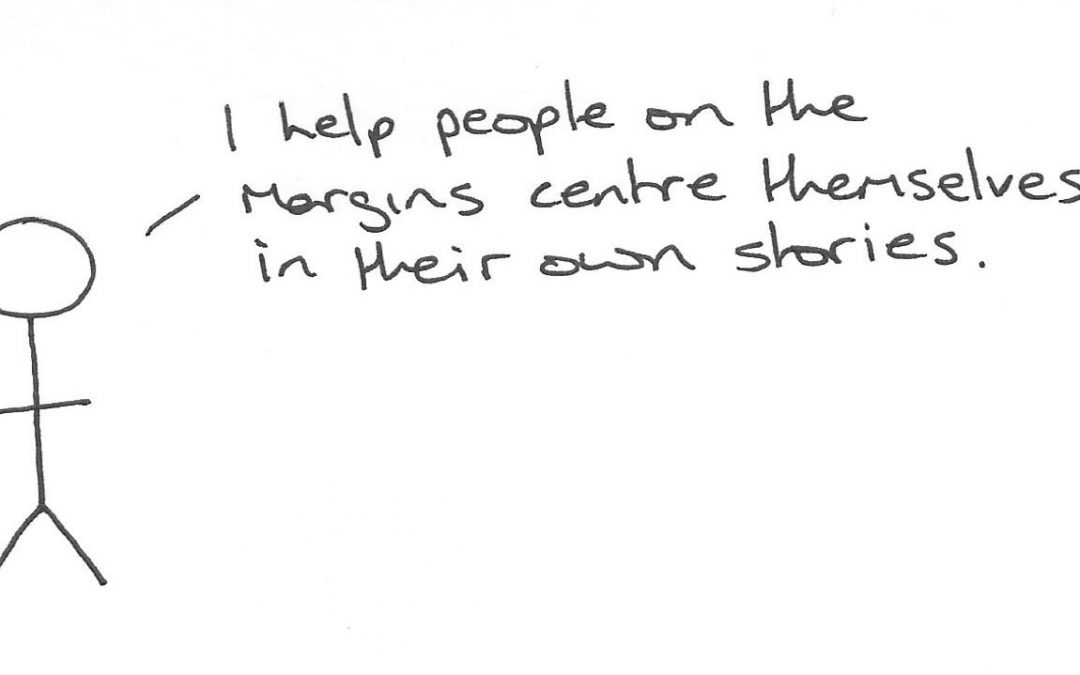At the end of November, I learned that I had been shortlisted for the Innovate Calgary RBC Social Enterprise Accelerator program.
I was very proud of this. The application was really well-done, and it was an accomplishment to have sat down and clarified what I want to do with this business, who I want to help, how I will help them, why there is value in this work. Because Innovate Calgary is a business-focused organization, and the Accelerator programs focus on helping entrepreneurs create profit as well as social benefit, the application really focused on the potential collaborations with business. I linked the self-care and narrative coaching to work I’ve done with Rebecca Sullivan on shifting leadership culture in large organizations*. I was really proud of it.
We spent a day putting the power point presentation together for the five-minute pitch.
It was going to be so good. I could picture myself standing in front of the judges, so convincing.

I could picture their responses. So enthusiastic! How could they not love it? This is important work! I am going to be so good at this, and it is so needed!

One of my most cherished personal stories – one of those stories that I come back to again and again – is that I am a good presenter, a good public speaker. I have loved giving presentations since I was a kid, and I have done public speaking in almost every professional job I’ve held. As the canine program coordinator at the Calgary Humane Society, I was interviewed on the news multiple times. As a dog trainer running my own company, I ran regular sessions for the Town of Okotoks on dog behaviour, and spoke to large groups about various topics. I facilitate workshops every month. I’m a public speaking rock star. I love it. I love it. And I’m good at it.
So, what happened on Jan 12 when I stood up in front of that panel of judges, with 8 months of business mentorship and networking and professional assistance on the line?
Clearly, I rocked it, right? I mean, I did all the positive thinking. I did the visualization. I had the positive self-storying down pat. I’m experienced. I know this stuff. I rocked it.
Except…

It was awful.
I wasn’t just awkward, I was a disaster. I panicked. I forgot everything I had planned on saying. I got stuck in a loop of saying “the stories people are told about who they are supposed to be” (I swear, I said that phrase probably twelve times), and I couldn’t get out of it. I started reading off the powerpoint slides, but then I panicked more because I know that’s terrible presentation form. I trailed off into awkward mid-sentence silence a couple times. After about seven minutes of my rambling (two minutes over the strict five minute limit), and less than halfway through my presentation, they cut me off. There were people waiting – the time limit was strict. The position was competitive, and mine was far from the only good idea being presented.
It was humiliating.
I felt sad, and ashamed, and disappointed.
I was proud of being shortlisted, and upset to have bombed so hard when it came down to it.
I failed.
I failed so hard.
On the way out to our cars, Rebecca told me that the business will happen either way and that it was okay.
I went home, and crawled into bed.
There were a million good reasons for my failure.
I was sick.
I was over-tired.
My throat hurt, my head hurt, and I was medicated.
I hadn’t had as much time to practice, because I had been sick.
Still, it was a failure.
And I don’t like failure.
I like to be really smart. Really witty. Really awkward, in a charming way. Really smart. Did I mention smart?
When I was a kid, this was foundational. I didn’t have a lot of friends, but I was very smart. I didn’t do well at sports, but I was very smart. And I was very smart in a very specific way – I was “book smart.” Word smart. Eloquent. Loquacious. (The former being a word I bandied about with obnoxious ubiquity as a precocious youth.)
That afternoon in front of that panel of judges with Innovate Calgary, I did not come across as particularly smart. I did not come across as eloquent. I came across as frazzled, and underprepared, and panicky. It hit me right in one of my most cherished core stories. It hit me right where I’m vulnerable.
This isn’t the first time I’ve taken a hit to this particular core story.
Fibromyalgia decimated my memory, my reading comprehension, my reading speed, and, for a few years, my ability to write. I’ve adapted now, but those were hard years and I still miss my old, pre-fibro mind.
The point of this post is two-fold.
First, it is an acknowledgement of how much I struggle with perfectionism, and shame, and unrealistic expectations of myself. I don’t want to be a self-care and narrative coach, I want to be the self-care and narrative coach. I am setting bars for myself that are literally impossible to clear on a first try, and those expectations are part of the reason it has taken me so many years to start actively pursuing this dream I’ve long held, of being able to help in this way. I want to change the world. I want to do it with my brain and with the power of my words, my narrative. I want that so badly. And I don’t want to fail on the way forward. I don’t want to trip and land on my face. I want to be at the end of the journey before I’ve even mapped the path. My clients will want that, too. You probably want that, in your own life. One point of this post is to say – I get it. I struggle with that, too.
I want to look that sharp and painfully deep desire fully in the face, and acknowledge it. Our most powerful and meaningful and beautiful dreams have the potential to fuel a shame machine that could push us into the shadows for years. Or, acknowledged and honoured and tempered with some humility (yikes, the vulnerability), these dreams have the potential to open doors for to address that shame and challenge, and even heal, those internalized narratives.
Second, it is a public acknowledgement of my failure. Not to beat myself up, but to remind myself that failure happens and that we survive it.
That our core stories can take a hit, and stay true.
It is an attempt to live within the narrative framework I’ve been working so hard to define – to know and welcome the positive and wholehearted truths about myself. To reframe and transform the narratives that are less wholehearted.
One of my core stories is that “Tiffany is smart.”
But I can reframe that. I can keep the part that feels whole and healthy – my love of books, my often-quick mind, my wordwizardy – and transform it into something with more space for failure and for adaptability.
“Tiffany loves books and words, and she is often sharp and insightful and able to convey a point.” (It is so much more true, and it doesn’t carry so many hierarchized ways of knowing – “smart,” with its implied corollary of “stupid.” With its implication that a “smart” person is somehow more valuable than a “stupid” person – these internalized oppressive hierarchies cause so much harm, and fuel so much shame and fear. Every voice is valuable. And there are many ways of knowing.)
In addition to healing my core story, I can add another story.
“Tiffany is brave enough to try something risky, and resilient enough to experience failure and keep going.”
That’s a pretty good story, I think.
I failed so hard, and I hated it. I still feel a flicker of shame when I remember it. But failure, and shame, do not have to be so powerful. They can be shifted into catalysts for change and invitations to compassion.
We can do this, my friends.
We can be brave, be vulnerable, be resilient.
We can get up and keep going, because we are so much more resilient than we know.
This post was available last week to my patrons. If you would like to see posts before they are made public, you can join the Patreon at www.patreon.com/sostarselfcare.
* This is a digression from the post, but the collaboration with Rebecca is really important. She’s been working with the Calgary Police Services, and I’ve been involved with that work, but the progress is so slow. Too slow. Organizations change at a glacial pace, and much like a glacier they grind the people at the bottom into dust. The weight of structural and systemic oppression, the constant microaggressions, the daily stereotype threat and the way it erodes resiliency… it’s great that organizations want to change, but while that slow change is happening, we must find a way to support the people who are being actively harmed during that painfully slow process. I think that there is a lot of potential in collaborating with organizations who are engaged in the process of pushing cultural change through and shifting towards equity and inclusivity and active, intentional diversity. Supporting the people who are suffering, so that once the leadership works through the process of addressing systemic and structural inequality, they haven’t crushed the people they’re changing to help.
Here’s part of the application:
There have been over 300 studies published in peer-reviewed journals regarding stereotype threat, and its pervasive negative effects. Stereotype threat, and the toxic narratives that drive it, undermine the ability of vulnerable identity groups to function in a variety of areas, including the workplace. It is a well-documented social challenge that impacts any person whose identity (their sense of self and their understanding of who they are in a social context) is impacted by stereotypes about their identity group’s ability to succeed in a certain situation. (Women’s performance in negotiations is a well-documented example of stereotype threat resulting in negative outcomes.)
One of the best ways to reduce stereotype threat and promote resilience is to give individuals tools that foster self-storying, self-awareness, and self-care. Resiliency models of intervention and empowerment have proven effective in raising consciousness about discrimination practices in a safe environment, and developing self-sufficiency skills to respond effectively and respectfully while maintaining maximum mental wellness.
Self-storying is one key practice of resiliency models. It gives employees the opportunity to use narrative to reframe a problem in ways that are both internally cohesive and strategically useful, meaning the individual has a sense of wholeness and authenticity, and a solid grounding in positive narratives of who they are and how they operate effectively in the world. Using narrative consciously and intentionally has been able to effectively, as David Denborough puts it, “retell the stories of our lives.”
Tiffany uses a variety of narrative approaches to teach self-storying, including leading clients through the process of identifying the harmful narratives they’ve internalized (the stereotype threats they are currently operating under) and also searching for possible resolutions to re-write those narratives and gain the confidence and support they need to move forward in their careers.
Self-awareness and self-care are parallel skillsets that allow clients to look clearly at what narratives they’ve internalized or are facing from colleagues, and to develop sustainable self-care strategies to help them build resilience to manage and eventually thrive in difficult situations.
It’s not reasonable to expect individuals who are facing threats to their emotional wellbeing and resilience because of sexism, racism, homophobia, transphobia, ableism, classism, and other identity threats, to wait indefinitely while organizations change. We must offer support at both the individual and the organizational level.
The goal of this coaching is not to “fix” the issues that clients are facing. Sexism, homophobia, transphobia, racism… these issues will not be fixed with positive thinking or by being the “right” kind of employee. Rather, the goal is to give clients the skills to be able to navigate on-going challenges and to thrive despite the issues they are facing. This is a significant departure from traditional models, which tend to focus on “fixing” the person and making hollow promises that if the individual changes, the organization will certainly follow.

